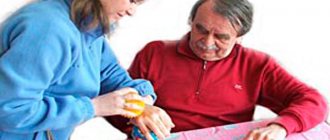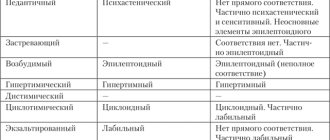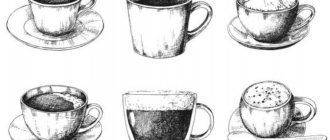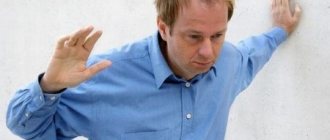Types of head tremors
Depending on the state of the body, tremor can be benign or pathological. In the first case, head tremors occur at rest or during vigorous activity and severe stress. Pathological tremor causes serious inconvenience to a person, interferes with normal life and requires special attention and treatment (how to treat head tremor will be described below). Benign tremor is the most common type of motor dysfunction. There are hereditary, cyanotic and juvenile tremor. As a rule, the development of the disease begins in childhood, especially progressing during puberty and
Rotations and nods
Exercises such as rotations and nodding are also useful. Rotations must be performed carefully, but with the greatest amplitude. It is best at this time to fix your gaze on some stationary object. Rotations should be done in both directions, 10 repetitions in each direction.
Nodding is a great option to cope with obsessive head tremors that many suffer from. You need to nod as hard as possible, trying to touch your chin to your chest. Then tilt your head back as far as possible.
It is also recommended to repeat these exercises several times a day, and be sure to combine them with breathing exercises, which were described above.
Head tremors - causes
Quite often, the cause of benign or pathological tremor is liver, kidney or pulmonary failure. It can also develop as a result of hyperthyroidism - hyperfunction of the thyroid gland. The most common cause of tremor in the elderly and senile is Parkinson's disease. Last but not least, this disease causes excessive accumulation of copper in the tissues of the liver, brain and blood. In addition, sweeping, rough involuntary movements can provoke such a rather serious disorder as damage to the cerebellum. It is quite difficult to get rid of tremor for those who suffer from alcoholism or drug addiction. The progression of the pathology in this case is influenced by the course of the disease. The tremor intensifies or may become permanent as the patient's condition worsens. It is possible that tremors may occur after chemical poisoning.
If you begin to notice that your hands are shaking, and this phenomenon is regular, then you should pay attention to it. After all, it can talk about both the body’s normal reaction, for example, to frostbite, and about any serious diseases. Why This article is dedicated to this issue. Below we will give the main reasons and find out why a person has
Physical overexertion
If you like to jog or work out in the gym, then you shouldn’t be surprised by this phenomenon. Shaking your hands a little over a short period of time is common. It will end as soon as your body recovers from physical activity.
Alcohol tremors
Why do you shake after drinking alcohol? It's simple - intoxication of the body makes itself felt in many ways, for example, by trembling of the muscles located on the face and tongue. You can suddenly overdo it with alcoholic drinks. Intoxication can affect any body, no matter how much you drank or what exactly you consumed. As a rule, as soon as the general condition of the body stabilizes, hand tremors also go away.
Depression, nervous disorders
Oddly enough, but for a person who has been in an apathetic state for a long time, a symptom such as hand trembling is normal. However, please note that if after two weeks the symptoms recur regularly or do not stop at all, then most likely this has nothing to do with depression.
Emotional turmoil, stress, stress
Why does your hand shake after you've been pretty nervous? Everything is very simple here - the body is thrown out of balance, and this reaction is completely justified. Any limb can tremble, and this will be normal. This symptom deserves attention only if it is repeated systematically. What does it mean? People's reactions to the same thing can be very different: someone will calmly react to the fact that the car has stalled in a traffic jam, for example, while others will be hysterical and emotionally worried. For the second type, trembling of the limbs is quite typical, due to the “exacerbation” of the nervous system. But if such a symptom appears too often, with every “inappropriate” reaction, then, most likely, the problems with the central nervous system are much deeper, and it makes sense to make an appointment with a doctor for diagnosis.
Elderly age
Why do older people's hands constantly shake? Unfortunately, this is normal for the body of grandparents, and trembling can be observed even at rest. It can also occur, which, by the way, affects both old people (from 57 years old) and young people.
Hypothermia
If you spend a long time in the cold or in a room with a low temperature, shaking your hands can be a common sign of frostbite. As in some of the previously described cases, it goes away immediately after the root cause is eliminated.
So, in this article we looked at the question of why the hand shakes. We hope that the information provided will be useful to you.
Sometimes people can observe sharp rhythmic unconscious muscle contractions - the head and hands shake, which in most cases is considered a sign of a serious neurological disease. However, there are other reasons for this condition. We will talk about them, as well as whether tremor of the head and hands can be treated in this article.
Why is my head shaking?
Tremor (shaking) of the head is manifested by vibrations or swaying of an involuntary nature. They may appear as small tremors or more sweeping movements back and forth, or from side to side. This phenomenon is most often associated with dysfunctions of the nervous system, but other causes are also possible. The condition of head tremors occurs at different ages; it can occur in both an infant and an elderly person. The difference will only be in the reason that provoked it.
Content
Causes of trembling head and hands
Clinicians identify possible causes of trembling of the head and hands:
- drug use and alcohol abuse, other types of pathological addiction;
- tremor of a hereditary nature (the so-called essential tremor, usually appears after 25 years);
- diseases and damage to the cerebellum;
- a consequence of taking certain medications;
- consequences of stress, prolonged or sudden fear;
- physiological tremors after severe fatigue, overexertion.
As you can see, there are quite a few reasons for trembling. Tremors can be caused by any psycho-emotional stress, for example, a student session or public speaking. Often, emotional tremors disappear on their own and do not require treatment. However, a consultation with a neuropsychiatrist will not hurt.
As for addictions, tremors can appear after consuming large doses of coffee, alcoholic beverages, drugs and medications.
Any physical activity must be dosed, since muscle strain can also cause tremors.
However, the most complex conditions are caused by pathological trembling, associated with the following reasons:
- Essential tremor is a hereditary disease characterized by the appearance of tremors, for example, only in the right or only in the left limb and head;
- Parkinson's disease - involuntary motor activity of the arms and head;
- diseases and injuries of the cerebellum - tremors combined with high-amplitude movements. It is often observed during oncological processes in the brain, with multiple sclerosis, and with pathologies of the cardiovascular system.
Traditional medicine - the use of herbal remedies
You can treat head tremor using more complex recipes with several components:
- Take three shares of motherwort, add two shares of hawthorn fruit, a share of crushed valerian root, and a pinch of mint leaves. Mix all components thoroughly, take two large spoons of the mixture, pour 500 ml of boiling water over them and place the container on low heat. After the drug boils, you should cook it for another 15 minutes, then pour the product into a thermos and keep it there for 120 minutes. After filtering, the infusion is taken as follows: in the morning, evening and lunch hours, 30 minutes before main meals. The duration of therapy is 30 days.
- The following infusion helps with essential tremor. In equal quantities, you need to mix dried and crushed cyanosis and motherwort, rosehip roots, mint and lemon balm, hop fruits and rosemary, and St. John's wort. Then 50 grams of the mixture is poured into the container and filled with 500 ml of vodka or diluted alcohol. The medicine must be infused in the dark for 21 days. Next, the product is filtered and used three times a day, before meals. A single dose is a small spoon and should be taken with water. Therapy should continue for 45 days.
- In equal proportions, you can mix peony and valerian roots, add the same amount of motherwort to them, chop and mix the components. Then place 50 grams of the collection in a glass container and fill it with alcohol, close tightly and place in the dark for 15 days. After the product is infused and filtered, it is taken in the morning and evening hours, 20 drops. They should first be diluted in half a glass of water.
- Before meals, you can drink the following collection. Mix 20 grams of hawthorn blossom with 20 grams of mint, add the same amount of lemon balm and astragalus. The raw materials are brewed in boiling water, the volume of which is 500 ml. The container with the drug is placed on low heat, wait until it boils, and cook for several minutes. Next, the liquid is filtered and taken half a glass before meals.
Symptoms of head and hand tremors
- If tremors develop in adolescence, and the process begins first on one hand, gradually spreading to the other hand, then to the chin, head, tongue, then benign senile tremor can be suspected. This disease may only appear at certain times. For example, after drinking alcohol, when experiencing anxiety. The trembling is especially noticeable when the arms are extended forward. Often, with this syndrome, taking some kind of sedative or sleeping pill is enough to calm the attack.
- If the head is dizzy and the hands are shaking, problems with balance arise, and the patient, if his eyes are closed, cannot touch the tip of his nose - we can talk about intentional trembling. This is a complex disease that should be treated by a neurologist. This disease is especially difficult if it is caused by excessive accumulation of copper in the body. In addition to trembling of the head and limbs, in this condition there is periodic flexion and extension of the joints of the arms or legs.
- If you have a headache and shaking hands, this may be due to diseases of the thyroid gland, the use of drugs or medications, or alcohol. This kind of trembling is small, especially noticeable when spreading your fingers or stretching your arms forward. The tremor does not disappear with general physical activity, and only intensifies when trying to concentrate on something.
- However, trembling in the hands and head is most often a symptom of Parkinson's disease - this is a fairly common disease, especially among the elderly. The disease is accompanied by weakness, unsteadiness of gait, speech impairment, forgetfulness, and gradual loss of facial expressions.
What to do if there is no effect
Indeed, sometimes it is not possible to cure head tremors with exercises alone. They help well if these manifestations arise as a result of osteochondrosis and other diseases of the spine. They are especially effective if the symptom is caused by muscle strain, poor circulation, or pinched nerve endings.
But if the trembling occurs as a result of alcoholism or Parkinson's disease, then a completely different approach to therapy is required.
Tremor can also develop with diseases of the endocrine system and liver damage. Then you must definitely start taking the necessary medications and not self-medicate. Exercises here will be absolutely powerless.
In many cases, gymnastics is recommended to be combined with taking sedatives, for example, infusion of valerian and B vitamins. In the most difficult cases, antidepressants are prescribed.
Diagnosis of head and hand tremors
At the very beginning of the diagnosis, the doctor pays attention to the nature of the symptoms and the circumstances under which they appear. Thus, the doctor collects anamnesis: asks about heredity, the presence of bad habits, lifestyle, and professional activities.
- computed tomography – helps to carefully examine all the necessary structures of the brain, which allows you to detect all the changes that are characteristic of Parkinson’s disease;
- positron emission tomography method of the brain - thanks to this procedure, it is possible to evaluate the activity and functionality of the brain, namely the departments responsible for movements. The same method reveals the lack of nerve cells that synthesize dopamine;
- single-photon computed tomography method - used to exclude the presence of neurological diseases, for example, Parkinson's disease;
- Magnetic resonance imaging – visualizes the functioning of the brain using a strong magnetic field, radio waves and computer imaging. Provides the opportunity to identify minimal changes in the brain structure, which makes it possible to exclude many serious diseases;
- The transcranial sonography method is an ultrasound recording of hyperechoic signals that occur in areas with high iron content. Allows you to detect neurological diseases even at the initial stages of their development;
- electroencephalography – a method for recording bioelectrical activity;
- evoked potential technique – determination of the electrically active response of the brain to the action of external stimuli;
- electromyography – gives an idea of the functionality of the neuromuscular system, which is explained by the bioelectrical activity of the muscles.
Differential diagnosis consists of searching for accompanying signs that may be characteristic of other pathologies.
Complications and consequences
If the patient's mental abilities are preserved, then no special complications should be expected. However, over time, attacks of head tremors can lead to a decrease in quality of life and loss of social communication.
With insufficient or improper treatment, the pathological process often spreads to other organs and muscles.
Uncontrolled movements in many patients become more pronounced and intense. Difficulties arise not only in the professional sphere, but also in everyday life: a person becomes unable to work.
Head tremors are a serious condition that requires immediate medical attention. This disease can lead to disorders of the musculoskeletal system, speech and writing disorders, and curvature of the cervical spine. The motor amplitude gradually decreases, often accompanied by unbearable headaches and discomfort in the neck area.
Tremor indicates that certain serious disturbances are occurring in the body that can lead to major problems: loss of speech function, inability to move the neck, or disability.
[22], [23], [24], [25], [26], [27]
Treatment for head and hand tremors
As with any disease, treatment for trembling depends on the cause of the symptom. Basically, drug, non-drug therapy or (if indicated) surgical intervention are prescribed.
Drug treatment is based on the use of drugs:
- ß-adrenergic blockers, which reduce the severity of symptoms (primidone, propranolol);
- drugs that eliminate seizures and tremor (clonazepam, gabapentin);
- sedatives (lorazepam, diazepam, etc.);
- B vitamins (mainly B6);
- Botox injections (i.m.).
Among non-drug treatments, physiotherapy and exercise therapy are preferable. The goal of such therapy is to restore muscle control and stabilize respiratory function (if diaphragmatic tremors are present).
Contrast showers, hardening, balneotherapy, and sanatorium-resort treatment have a good effect. The patient is prescribed fortified nutrition, reflexology, manual therapy and massage.
Surgical intervention is prescribed for severe diseases (essential tremor) when drug therapy is ineffective. The operation can be of the following type:
- impact on the nuclei of the hypothalamus (the brain area responsible for the relationship with other parts of the brain);
- neurostimulation of brain areas - conducting electrical impulses that activate certain areas of the brain, which helps eliminate or reduce tremors.
Traditional treatment includes apitherapy (bee stings), hirudotherapy (leech treatment) and herbal medicine. Among herbal remedies, plants such as valerian root, oregano, mint, motherwort, hop cones, and wormwood are used in the form of infusions.
For additional muscle relaxation, auto-training, yoga, Pilates, and breathing exercises are used. Swimming in the pool, massages, and any water procedures are useful.
Surely each of us has met people in our lives whose heads are shaking and who are unable to control this process. At the same time, your hands may also tremble. This phenomenon is called tremor in medicine. This disease is typical primarily for older people, but it is often observed in young people. What are the causes of tremor? In this article we will tell you why your head shakes.
Healing baths
Baths using different plants will help cope with tremors due to their relaxing and sedative effect.
Soothing bath
A simple but effective treatment is baths, for the preparation of which you can use dried valerian root, chamomile flowers, St. John's wort and wormwood, linden inflorescences . Any of the listed plants in the amount of ten tablespoons should be poured into 500 ml of boiling water and left in a closed container for half an hour. Afterwards, the product is filtered and poured into a bath, which must be taken for about 20 minutes. It is best to carry out such procedures before a night's rest.
Chrysanthemum
An excellent sedative is chrysanthemum flowers, the infusion of which is recommended to take healing baths. To do this, the flowers are crushed and poured into a bag made of gauze. It should be immersed in boiling water (1 liter) and left for 30 minutes, then pour the product into the bath. The duration of the procedure is 15 minutes.
Sage
For tremors of the head, limbs and other parts of the body, use a bath with sage, which helps the body to completely relax. Dry crushed flowers of the plant along with its leaves are brewed in 1000 ml of boiling water and kept on low heat for another ten minutes. After this, the product is filtered, the cake is squeezed out, and the medicine is poured into the bath. The duration of the procedure is 15 minutes.
Main types of tremor
Depending on the causes of occurrence, there are three main types of tremor:
- benign;
- postural;
- intentional.
The first type is a condition when there is no visible reason why the head is shaking. This is the most famous type on the list of movement disorders. It usually manifests itself in the transition period and begins with one hand, and then moves to the second. Then the head trembling usually begins. The phenomenon intensifies with nervous excitement and the use of alcohol.
Postural tremor is most often a consequence of hereditary predisposition, hyperfunction of the thyroid gland and increased anxiety. It intensifies, as a rule, when a person tries to reduce trembling.
Intention tremor occurs against the background of lesions of the cerebellum, which is responsible for a person’s balance when walking.
Differential diagnosis
Differential diagnosis should be carried out with Parkinson's disease, Wilson's disease, and if tremor is detected in patients under 50 years of age, it is necessary to exclude hepatolenticular degeneration.
[29], [30], [31], [32], [33], [34], [35], [36], [37]
Content:
Treatment of head tremor should be comprehensive and can only be prescribed by a doctor. In addition to taking medications and physical therapy, specially designed exercises can be used.
It is recommended to perform them regularly and at home. However, exercise alone cannot overcome this symptom.
Causes of tremor
The main reasons why the head and hands shake are the following conditions:
- stressful conditions, including fears and emotional stress;
- alcohol addiction;
- drug addiction;
- medications;
- excessive physical exertion during exercise, etc.;
- cerebellar disease;
- heredity.
Separately, it should be noted the diseases against which tremor of the head and hands most often develops. Among them are the following diseases:
- hyperthyroidism;
- alcoholism;
- Wilson-Konovalov disease;
- Parkinson's disease;
- renal failure;
- liver failure;
- respiratory failure;
- poisoning with salts of heavy metals;
- midbrain lesions.
Avoid risks
First of all, you need to lead a healthy lifestyle.
No alcohol, drugs, or smoking. Follow a daily routine, try to sleep at least 9 hours. Try to get as many pleasant emotions as possible. Contact a specialist at the slightest suspicion of illness.
There is no need to be ashamed of head tremors and try to hide this condition, it won’t work anyway. Don't hide from the problem, thinking that everything will go away on its own, it won't happen.
Sound the alarm at the slightest symptoms, consult a doctor and everything can still be improved for the better. Take care of yourself and be healthy!
source
External manifestations
Even if the head shaking is not accompanied by incoordination or twitching of the arms and legs, a whole range of variable movements can be observed:
- fine trembling of increasing frequency;
- the feeling that everything is “floating” before your eyes;
- sweeping swings: back and forth, up and down, left and right with possible increase in amplitude;
- the addition of uncontrolled movements of the tongue, facial muscles, lips or chin;
- speech disorders, as well as voice modulations;
- trembling of the eyeballs;
- increased involuntary vibrations when trying to control them.
The patient rarely experiences pain or physical discomfort, but the process of communication becomes difficult and unpleasant for him, and problems arise when carrying out everyday tasks related to living or working. This affects not only physical health, but also harmony in the psycho-emotional sphere of a person’s life.
Features of treatment
If pathology occurs, the patient will need to undergo a long course of therapy. A neurologist is involved in developing a treatment regimen. For the disease, drug therapy is most often used. Patients are recommended medications that have calming properties and stabilize the patient’s emotional state.
- Adrenergic blockers. With the help of medications, the severity of the symptoms of the pathology is reduced.
- Beta blockers. For tremor, the patient should take 40-100 milligrams of the drug per day.
- Diazepine and its derivatives. To increase the effectiveness of the medication, it is recommended to take Anaprilin or Antelepsin simultaneously.
- Metoprolol. With the help of the medicine, head tremors are treated, in which spasms are diagnosed.
- Vitamin B6. The action of the medicine is aimed at improving serotonin metabolism and the general condition of the body.
- Clonazepam. Patients are recommended to take the medicine three times a day, 1-2 milligrams. During treatment with the drug, simultaneous use of Propranolol is allowed.
- Primidona. For tremors, patients are allowed to take a maximum of 0.75 milligrams of medication. Taking the drug is allowed in old age under the supervision of a doctor, as it is characterized by the presence of a large number of undesirable effects.
- Propranolol. The drug is not recommended for diseases of the cardiovascular system, as this can lead to complications.
If the pathological process occurs due to problems with the neck, then the use of manual therapy is recommended. Relaxation and self-massage techniques have a high effect. If the patient is in a calm state, this will have a positive effect on the outcome of the treatment. Patients are recommended to exercise.
In case of a pathological process, treatment can be carried out using traditional medicine. An oat-based medicine is effective. Take 3 tablespoons of the component and pour a glass of boiling water. The medicine is boiled for 1 hour over moderate heat. After 24 infusions, the drug is used for oral administration.
To improve the condition, the patient is recommended to chew dried tansy flowers. Relaxing baths have a high effect on tremors. Before they are carried out, infusions of plants such as chamomile, linden, St. John's wort, and wormwood are added to the water. It is recommended to take a bath in the evening before bed for 15 minutes.
Head tremor is a serious pathological process that brings physical and psychological discomfort to the patient. That is why, when this symptom appears, it is recommended to seek help from a doctor. The specialist prescribes diagnostic measures, which allows you to determine the type of disease. In accordance with this, an effective treatment regimen is developed for the patient.
Having differentiated head trembling according to common groups of pathologies, the following etiopathogenetic types are distinguished:
- Essential tremor Minor. A hereditary disease is transmitted through one or more generations. Occurs when moving or holding the head. May be accompanied by other types of tremors.
- Parkinsonian. It is characterized by the appearance of tremors at rest and a decrease in amplitude during movement, as well as a complete absence during sleep. Isolated vibrations of the head are not diagnosed; more often the lower jaw, tongue, lips, legs, and sometimes the torso are added. In old age, Parkinson's disease is considered a common cause.
- Cerebellar (cerebellar). This type is caused by damage to the cerebellum; more often it is intentional (hand trembling when trying to perform a precise action). However, with lesions of the median structures of the cerebellum, trembling occurs in the head and torso. Accompanied by small jerky movements or a persistent inability to perform coordinated actions (asynergy).
- Dystonic. A feature of this type is the instability of the amplitude and frequency of vibration. The part of the body in which hyperkinesis is present vibrates. A typical example is head tremor with spasmodic torticollis (cervical dystonia), which disappears with rest.
- Neuropathic. Close to essential; The reason for the appearance is disruption of the functioning of nerve fibers. The latter can be either idiopathic (congenital) or acquired due to metabolic disorders (diabetic or uremic neuropathy), vascular spasms, and tumors. May be aggravated by a lack of vitamins (B12, folic acid), as well as alcohol abuse or excessive medication.
- Holmes tremor (rubral). Trembling occurs both at rest and when moving or trying to hold the head. This is a difficult type of tremor, since its appearance indicates the presence of foci of damage to the midbrain, which is responsible for controlling movement. This type is typical for strokes, multiple sclerosis, tumors or traumatic brain injuries.
- Psychogenic (hysterical). This type is difficult to define and classify, since trembling occurs both in a calm state and is expressed posturally: arms outstretched in front of you shake. The attack is characterized by a sudden onset, unexpected weakening and the presence of complex types of oscillatory movements. The disorder is aggravated when a person is nervous, and is leveled when the patient’s attention switches.
Physiological postural variation is a common sign of alcohol withdrawal (withdrawal syndrome) or a condition caused by intoxication due to alcohol intake (hangover).
Swimming
Swimming is the best method to get rid of osteochondrosis and other neck diseases, which most often lead to involuntary movements. You should only swim in an indoor pool, and do this several times a week, regardless of the time of year.
Swimming has a general strengthening effect on all muscle groups, helps to cope with the tone and tension of muscle tissue, and has a relaxing effect. In addition, it perfectly helps to cope with mental stress and forget about problems and worries for a while.
It is for this reason that it is useful to include swimming in the treatment of head tremors. But before you start visiting the pool, you should consult your doctor.
Peculiarities of children's symptoms
The occurrence of a pathological process is observed regardless of the patient’s age. This process affects the lips, tongue, larynx, and jaw. During the course of the pathological process, patients have a shaking head. This symptom is noticeable not only to him, but also to others. If the patient begins to control the symptom, this leads to an increase in the severity of symptoms.
In the pathological process, uncontrolled movement of facial expressions and tongue is diagnosed. A person moves his head in increasing amplitude. Patients note that their fine tremors gradually intensify. If the patient is in a calm state or sleeping, then no head shaking is observed.
If signs of pathology occur, the patient should consult a doctor, who, after determining the type of disease, will prescribe effective treatment. When visiting a specialist, the patient is examined and a medical history is taken. This allows the doctor to make a preliminary diagnosis. To confirm it, the use of instrumental and laboratory techniques is recommended.
Patients are recommended to undergo a general and biochemical blood test. During the course of the disease, it is necessary to conduct a computer study of the brain:
- angiography;
- computed tomography;
- electroencephalography;
- magnetic resonance imaging.
If a patient's symptom occurs, an x-ray examination is recommended. If necessary, genetic testing is carried out.
Head trembling is accompanied by additional symptoms, if they occur, it is recommended to seek help from a doctor. Only a specialist, after carrying out diagnostic measures, will prescribe effective treatment to the patient.
The head is manifested by involuntary rhythmic twitching or shaking of the head. These movements can take the form of trembling or sweeping vibrations, and can be directed up and down or left and right.
Head tremors can occur at any age: in infants, adults, and the elderly.
Head tremor, depending on the state of the body, is divided into benign (physiological) and pathological.
With benign tremor, involuntary head movements occur at rest, or during vigorous activity, or under severe stress. Physiological tremor is characterized by short episodic manifestations, lack of progression, and long periods of remission. A person may not even feel their own shaking with benign tremor. Physiological tremor can sometimes be invisible to others.
In infants up to two months of age, head tremor is considered normal and occurs in every second child. Tremor occurs when the baby cries or during the rapid phase of sleep. Parents should not be afraid of such twitching of the baby's head, but they should report the tremor to the pediatrician.
Pathological head tremor, caused by one or another disease, interferes with the normal functioning of a person. Tremor does not cause pain, but it causes significant inconvenience when performing even the simplest functions: dressing, eating and drinking. It is visible from the outside with the naked eye.
The causes of head tremors are varied:
- neuropathic tremor develops as a consequence of disturbances in the functioning of the nervous system. As a rule, psychotherapy and systemic administration of sedatives are sufficient for its treatment;
- cerebellar tremor develops against the background of dysfunction of the part of the brain that is responsible for maintaining balance, muscle tone, and coordination of movements. This type of disorder occurs with unilateral brain damage as a result of a stroke or the appearance of a neoplasm. Also, a symptom of cerebellar tremor can be a serious consequence of alcoholism, drug addiction, or uncontrolled use of medications;
- the development of Parkinson's disease is sometimes accompanied by head tremors in elderly patients. Unfortunately, degenerative brain changes cannot be cured. In such situations, medical care is intended to relieve ongoing symptoms of head tremors and slow down degeneration;
- Essential tremor is caused by heredity. The symptom looks like shaking the head and is definitely a benign manifestation. Despite the fact that genetics has not yet discovered the gene responsible for tremor, hereditary factors play an important role in its occurrence. The patient does not experience pain, there are no other symptoms and no decrease in intelligence. This is the only type of tremor, the attack of which can be stopped by taking a minimal dose of alcohol. At one time, such a test became the basis for differential diagnosis in recognizing Parkinson's disease and essential tremor in the clinic of the famous neurologist J. M. Charcot.
Head tremors in children can also be physiological, but sometimes they are caused by pathologies in the development of the endocrine or nervous systems. The following can cause head trembling in a baby:
- prolonged hysteria, during which the child experiences spasms;
- pathological childbirth;
- infections suffered by a woman during pregnancy;
- mother's drug or alcohol addiction;
- insufficient level of formation of peripheral nerve endings;
- metabolic disorders, expressed by changes in the concentration of glucose, calcium or magnesium in the blood;
- intrauterine strokes.
Episodes of trembling in children up to puberty are a completely harmless phenomenon, signaling the immaturity of the nervous system. However, if difficulties in performing precise actions or maintaining peace, involuntary convulsions, impaired motor skills of the body, headaches, sleep and mental disorders are added, then the child requires examination by a neurologist or endocrinologist.







